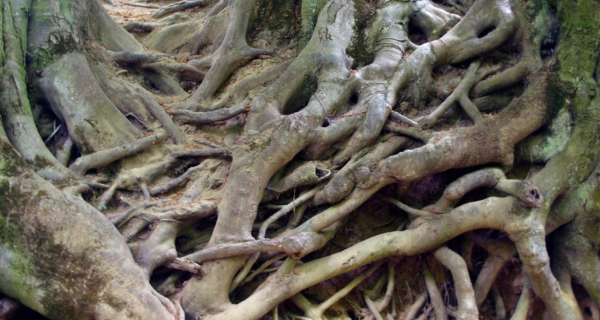Ith, blicht, síth, sáma sona,
lína lána, lerthola,
fir ríglaich, co combáid cind
dirmaig forráin
Corn, milk, peace, happy ease,
full nets, ocean’s plenty,
Men of worth, amity among chieftains
-The Dindshenchas of Carmun, 11th century
Botanical name: Sorbus
Family: Rosaceae
Ogham: Lus
Scots Gaelic: Caorann
Irish Gaelic: Caorthann
Welsh: Criafol
Message: Walk forward, confident in the knowledge that you are part of the pattern. Disharmony is only a passing thing. It cannot touch you.
Lie down beneath a rowan tree and look up between the branches. Breathe. Watch green and gold leaf-shadows spangling the grass around the trunk. Watch the red berries gleaming in the sun, nibbled at by flitting birds. Breathe in the smell of green things growing. And that’s when you realize one thing:
Life is good.
The rowan tree is the physical embodiment of this sense of perfect well-being. Sometimes the tree looks so perfect, so beautiful, that it’s hard to believe it’s real.
Perhaps it truly isn’t of this world. In the “Tale of the Wood of Dubhros”, it’s written that the Tuatha De Danann brought the first rowan berries into the world of men.
“Now the provision the Men of Danu had brought with them from the Land of Promise was crimson nuts, and apples, and sweet-smelling rowan berries. And as they were passing through the district of Ui Fiachrach by the Muaidh, a berry of the rowan tree fell from them, and a young tree grew up from it. And there was virtue in its berries, and no sickness or disease would ever come on any person that would eat them, and those that would eat them would feel the liveliness of wine and the satisfaction of mead in them, and any old person of a hundred years that would eat them would go back to be young again, and any young girl that would eat them would grow to be a flower of beauty.” (1)
The rowan tree holds this virtue today, and in its presence no discord and no obstacle can last.
Some say it was the lady Brighid herself who dropped the berry that birthed the first rowan tree (2) and indeed, the rowan is sacred to the lady of the hearth and the smithy, her gift to mankind. The sheer wholesome vitality of rowan is enough to fight off unclean things; rowan berries are tucked in pockets to ward off mischief, untruth, and ill intent on the part of man and spirit (3), rowan wood is hung over a cradle to ensure the child is not influenced by evil (4), and rowan berries on the door and window lintels of a home protect against bane and blight entering.
Rowan was used in all the great fire festivals of the Irish: at Imbolg, its red berries were soaked in cream and fed to children and domestic animals to strengthen them. At Beltane, rowan was burned to bless the fertility of the coming harvest and ward off all bane or blight. As the night closed in on Samhain, it was equal armed rowan-wood crosses tied with red thread that protected the folk from the forces of the dark. (4)
When warding off disease, discord and evil, there is no better tree to turn to than the rowan. In the dark and terrible days of winter in northern Europe, tisanes, jams and meads made with rowan berries kept the folk healthy, providing essential supplements of vitamin A and C to ward off scurvy, rickets, and compromised immune systems that led to winter ills. To eat the rowan berries in the dark time of year was “to eat a mouthful of Midsummer.” (5)
Rowan is the tree that burns brightest, and we call on it when we most need light. When you look up into the rowan’s fine leaves dappled with sunlight, and watch light glint from its carmine berries, you can almost hear it speak. “Life is beautiful,” the rowan says in words of dappled light and color, “open your eyes and see it.” Its fid in the Ogham, Lus, means ‘flame’ or ‘radiance’, (6) and in its supple limbs and burning red berries is the pure fire of life. In the light of that fire, all impurity is burned away, and all obstacles are shown to be lessons to help you become greater.
When the rowan is with you, it is time to step out boldly in the certain knowledge that you are part of a perfect pattern, all things in their place and all things blessed.
- Gods and Fighting Men: The Story of Tuatha de Danann and of the Fianna of Ireland, Augusta, Lady Gregory, Harvard Press, 1905
- A Druid’s Herbal of Sacred Tree Medicine, Hopman, Ellen, Destiny Books, 1994
- Ogam: Weaving Word Wisdom, Laurie, Erynn Rowan, Megalithica Books, 2007
- Kindling the Celtic Spirit: Ancient Traditions to Illumine Your Life Through the Seasons, Freeman, Mara, HarperCollins Publishers, 2000
- Ortha nan Gàidheal: Carmina Gadelica, Carmichael, Alexander (ed.), Edinburgh Press, 2006
- Ogam: Weaving Word Wisdom, Laurie, Erynn Rowan, Megalithica Books, 2007

